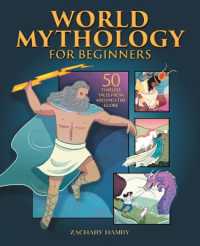Full Description
This book introduces a new linguistic reconstruction of the phonology, morphology, and lexicon of Old Chinese, the first Sino-Tibetan language to be reduced to writing. Old Chinese is the language of the earliest Chinese classical texts (1st millennium BCE) and the ancestor of later varieties of Chinese, including all modern Chinese dialects. William Baxter and Laurent Sagart's new reconstruction of Old Chinese moves beyond earlier reconstructions by taking into account important new evidence that has recently become available: better documentation of Chinese dialects that preserve archaic features, such as the Min and Waxiang dialects; better documentation of languages with very early loanwords from Chinese, such as the Hmong-Mien, Tai-Kadai and Vietnamese languages; and a flood of Chinese manuscripts from the first millennium BCE, excavated or discovered in the last several decades. Baxter and Sagart also incorporate recent advances in our understanding of the derivational processes that connect different words that have the same root. They expand our knowledge of Chinese etymology and identify, for the first time, phonological markers of pre-Han dialects, such as the development of *r to -j in a group of east coast dialects, but to -n elsewhere.
The most up-to-date reconstruction available, Old Chinese: A New Reconstruction brings the methodology of Old Chinese reconstruction closer to that of comparative reconstructions that have been used successfully in other language families. It is critical reading for anyone seeking an advanced understanding of Old Chinese.
Contents
1 Introduction ; 1.1 What is Old Chinese? ; 1.2 Methodology ; 1.3 Plan of the book ; 2 The evidence for Old Chinese ; 2.1 Middle Chinese ; 2.2 Old Chinese rhyme evidence ; 2.3 Evidence from the Chinese script ; 2.4 Modern Chinese dialects ; 2.5 Early Chinese loanwords in other languages ; 2.6 Traditional Chinese texts explicitly discussing language ; 2.7 Tibeto-Burman ; 3 An overview of the reconstruction ; 3.1 Onsets: main hypotheses ; 3.2 Rhymes ; 3.3 Root structure, word structure, and affixation ; 3.4 The nature of the pre-Qin script ; 4 Onsets ; 4.1 The evolution of Old Chinese initial consonants: major processes ; 4.2 Applying the comparative method within Chinese ; 4.3 Singleton onsets ; 4.4 Tightly attached onsets ; 4.5 Onsets with loosely attached preinitials ; 4.6 Onsets with complex preinitials ; 5 Old Chinese rhymes ; 5.1 Overview: vowels, codas, postcodas ; 5.2 The six-vowel system ; 5.3 Rhyme development: main processes ; 5.4 Rhymes with back codas (*-O, *-k, and *-?) ; 5.5 Rhymes with acute codas (*-j, *-t, *-n, and *-r) ; 5.6 Rhymes with the codas *-w and *-wk ; 5.7 Rhymes with labial codas (*-p and *-m) ; 6 Conclusion ; 6.1 What kind of language was Old Chinese? ; 6.2 Dialect differences in Old Chinese ; 6.3 Known issues ; 6.4 General directions for future researc ; 6.5 Old Chinese in broad comparative context ; Appendix of reconstructed forms ; References







